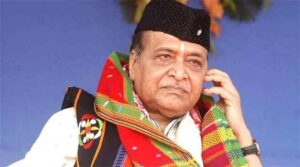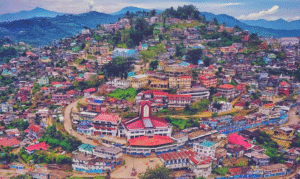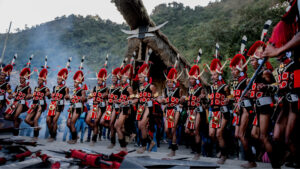In the heart of Shillong, Meghalaya, lives a legend – Dylan Majaw. Not just a name etched in rock, Dylan’s music is a bridge between generations trying to find their own voice in the world. For over 50 years, his vibrant voice has voiced stories of the joys and struggles of a people.
Unlike your typical rockstar, Dylan hasn’t traded his roots for fame. He still breathes the air of Shillong, the city that nurtured his dreams and continues to fuel his fiery spirit. His music is a conversation, a mirror reflecting the soul of the Northeast and its exciting energy.
Dylan’s legacy isn’t measured in awards; it’s etched in the hearts of those touched by his soulful melodies. He’s a beacon of hope for aspiring musicians, a testament to the enduring power of raw talent and dedication.
Journey as Louis Lewis
Lou Majaw was born on April 14, 1947, in Mawlai, Phudmari, Shandong. He was born into a poor family and music wasn’t an investment his parents were willing to make. He had his first guitar lesson at The Sacred Hearts Boy’s Boarding School in 1955. After transferring to Don Bosco Technical School in 1959 to pursue a career in tailoring, he learned to play guitar, side drum, genus, saxophone, and trumpet in the school orchestra for the following three years, until 1962.
He took advantage of a chance to travel in 1965 and went to Calcutta. After some early difficulties, he started performing at Park Street, which later became the Indian music industry’s hotspot.
He performed and sang with bands like Little Richard, Small Frys, and Oracle Bones. Mr. Joshua, the proprietor of Trinca’s, saw his ability as a solo performer and gave him a solo slot and a stage name, Louis Lewis.
Lou Majaw began polishing his skills as a musician and performer here. Additionally, a lot was occurring in the world of rock and roll during this period-the birth of rock, the rise of the singer-songwriter, the invention of new sounds, and the electric guitar’s astounding technological advancements.
How did his career come to be?
At that time nobody dared to play their music. There weren’t audiences for that but a few like Dylan dared to write and play his songs. He set the trends away from playing Western rock music by famed bands in the 1970s. This brought him great recognition and fame, especially in the Northeastern states.
The Great Society Band
In the year 1977, Majaw established his band, ‘The Great Society’. It was a holy grail for music in Northeast India. It was more than a band, it was the very idea behind the institution of Northeastern rock music.
The great society educates people about the conditions of the state and music. It tries to make it more inclusive of the world by sharing messages. It is an educational platform.
Majaw’s work
Lou Majaw isn’t just a singer. He is a storyteller, a social commentator, and a cultural icon. His powerful voice and lyrics resonate with a generation weaving tales of love, loss, and the Khasi way of living.
He witnessed the Khasi Hills undergo the throes of change. Colonialism, independence, and the fight for cultural identity found expression in his music. He drew inspiration from traditional Khasi music, blending it with folk and rock influences to create a sound that was uniquely his own.
Songs like “Ka Lynti Mynken” (The Star Shines), is a passionate ode to a lost love. He touches hearts with raw emotion and relatable themes sung in songs like “Nongrim Nongbah” (Our Village) which evokes the nostalgia of home.
In “Jingkyrmen ka Ri Khasi” (The Weeping of the Khasi Land), he mourned the environmental degradation threatening his beloved Meghalaya. Songs like “Ka Heroin” (The Heroin) addressed social issues like drug abuse with unflinching honesty, urging awareness and action.
His lyrics, often delivered in the Pnar and Khasi languages, weren’t mere rhymes; they were poetry. They painted vivid pictures, capturing the lush greenery of the hills, the warmth of community gatherings, and the pain of injustice. He used metaphors and similes drawn from nature and Khasi folklore, making his music even more deeply rooted in his cultural heritage.
A Tribute to Bob Dylan
Lou always keeps Bob Dylan in his gratitude. Ever since the 1960s, Bob inspired Lou to write his songs. Majaw was beginning to emerge as the Eastern counterpart of the American folkie, as Dylan sang about the injustices that were occurring at the time. Majaw, who was raised in the folk culture, also had a gift for creating organic instruments that were used to narrate tales of those who were unable to speak for themselves.
“The simplicity yet depth of Dylan’s songs really got to me. There’s so much hope and wisdom. You see beyond the trees, into the forest, and so many things. He makes you feel what you see and hear. That is his beauty. No other lyricist has that power, magic.”
Lou’s Charisma
Lou Majaw has made an incomparable contribution to Meghalaya, its artists, and popular culture. Lou, known for his shorts and grey-grown hair, is a brand unto himself. He wasn’t a planner. He never went to find the music, rather, it came to him in the moment.
Lou Majaw’s impact transcends language and borders. He’s not just a North-Eastern icon; he’s a voice for indigenous communities across India, fighting for their rights and advocating for environmental protection. His music has influenced countless artists, inspiring a generation to embrace their roots and speak their truth.
His music isn’t just entertainment; it’s a journey into the heart of a land and its people. It holds the power to heal, inspire, and challenge. Ancestral truths, echoes of change, and the spirit of his community in Shillong paves a way through his music.
Unravelling a billion untold stories, one chapter at a time, Humans of Northeast takes you on a discovery through vibrant Northeast India – a land rich in people, places, and culture. Ready to immerse yourself in more such stories?
Visit our page HONEI to read more about narratives that inspire and uplift.






